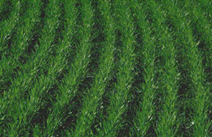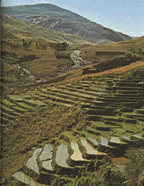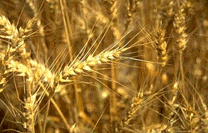 AGRICULTURE AGRICULTURE |
The agricultural vocation of the Big Island is undeniable, and it could benefit from the consumers' demand in developed economies for biological products. Everything grows incredibly well in this huge country of 587,000 sq. Km. generously endowed. Thanks to the diversity of its climate, an extremely rich environment that entails several well-differentiated agro-ecological zones, the Big Island can adapt to different types of agriculture, such as products from tropical and temperate climates or products from different seasons that can be grown at the same time. Extending farming areas is still possible with 9,5 million Has. of untapped and fertile lands that are only waiting to be toiled. This is one of the reasons why the State started - with donors' support among others - to restore the irrigation networks, water and land management. As a result, agriculture registered a positive growth rate of 4.1% in 1999 after a -1.8% performance in 1998.

Food crops are for self-consumption. Having to face transportations issues when dispatching their products, fearing to see their surplus rotting in the fields or given as fodder to the cattle, farmers have lost their motivation. This is probably why the level of production for certain products is sinking. In the 1960's Madagascar exported 13,000 tons of maniocs, 6,000 tons of tapioca and 4,000 tons of starch. At that time, the seven starch factories, with an overall capacity of 100,000 tons, processed 40-50,000 tons of maniocs. Today the country is not even able to supply its local demand.
Being rice the staple food of Malagasy, its farming remains inescapable. What's more, considering the favorable natural conditions for its cultivation, it is easy to obtain two or three crops a year. The rice sector employs nearly 1,750,000 people, its contribution to the national GDP is 12% and to agriculture 43%. However, the production of rice is not sold that easily on the domestic market. Imported rice floods the market and is being sold at lower prices than local products; obviously this solution is seriously hurting local farmers. Today's objective is to make local rice more competitive, to improve productivity per hectare by introducing better yielding varieties and by making agricultural techniques easily available. The issue of infrastructures will also need to be tackled, as it is one of the crucial impediments to a better supply of the Island. As Mr. Raveloarijaona, Minister of Agriculture says: "as far as rice production is concerned, we consider that our local consumption is 2,400,000 tons, when we actually produce 2,600,000 tons. But with the issue of infrastructures, and particularly with road transportation, we are facing serious difficulties to dispatch our products and to direct them to large consumption areas, so we are forced to import".

Conscious that wheat is cash crop that can consequently generate revenues to producers, Madagascar started producing it at the start of the 1980's, in particular in the Vakinankaratra region. After a period of stagnation, the sector experienced a new dynamism due to a higher demand on international markets and attractive commodity prices.
The relatively cool climate and fertility of the soil in certain regions of the Big Island have allowed for the development of vegetable and fruit farming. Once again, due to the lack of infrastructures, large quantities of fruits and vegetables rotten. Hence, with the new trend for biological products, Madagascar would have an excellent opportunity to export large quantities. What's more, the demand for dehydrated fruits and vegetables used in soups, sauces, baby food and seasonings is very strong in international markets. Peaches, apples, green beans, peppers, pears, onions, carrots, cabbages and tomatoes produced in large quantities in the country are ideal for similar processing. | 
The islands of the Indian Ocean represent potential markets. The Big Island could cope with the demand of corn for the Réunion Island at very competitive prices, whereas presently it has to import 40,000 tons from Argentina. Likewise, Mauritius imports jams, jellies, marmalades, purees and fruit paste from South Africa. Actually in 1997, South Africa also exported large amounts of fresh fruits, vegetable and fruit juices to Mauritius. There are so many opportunities Madagascar could grab but that require investments. Investments must first secure the regular supply of the Island and then focus on international standards for quality and packaging for instance. However investments are not within farmers' reach or even hardly available to national operators looking for partners.
Some of the land, particularly in the coast, is devoted to cash crops. Crops vulnerable to weather conditions and price fluctuations on the international markets. Today coffee is going through major difficulties due to overproduction and to a decline in quality of the Malagasy production (mostly linked to its aging plants, and to inadequate packaging). If in the 1970's, under the first republic, Madagascar was exporting 70,000 tons, now it hardly reaches 40,000 tons. The Robusta variety is the most cultivated one in the island whereas Arabica, preferred by consumers, does not represent but 5% of the Malagasy production. In 2001 with the decrease of prices, farmers had trouble selling their produce and had to cut their rates. By taking control over this sector, Madagascar could increase the volume of its exports to its main clients: Europe, USA, Japan, and, why not, find again its previous position on the international markets.
Madagascar's cocoa is considered among the best in the world, but exports remain marginal - below 4,000 tons. Clove, grown all over the East Coast, due to climatic hazards and to the aging of its plants has been replaced by Indonesian clove. The Big Island is today the world's fifth largest producer. Vanilla has fended better. Madagascar remains the first vanilla producer in the world and it can boast the best quality of Bourbon vanilla. Big efforts have been done in order to keep the quality of products exported to the USA, France, Germany and Japan.
Madagascar had high hopes on industrial crops such as cotton, sugar cane and tobacco, but these productions have known ups and downs and the country had difficulties to keep them afloat. The cotton sector has a great future, especially since the AGOA initiative, and considering the number of textile companies that should consequently move to the free trade zones. The Minister of Agriculture, Mr. Raveloarijaona, remains cautious: " the sector is closely linked to the fluctuations of world prices". About 21,730 planters are involved in the cotton industry which spreads over 50,000 Has particularly between the Mahajanga and Toliara provinces. Hasyma, that took over the French Company for the Development of Textile Fibers (Compagnie Française pour le Dévéloppement des Fibres Textiles - CFDT), and which is to be privatized, has a monopoly over the sector. CFDT, which on the meantime has been renamed "Développement des Agro-Industries du Sud" or DAGRIS, is the strategic investor interested in taking full control of Hasyma. Hasyma's Managing Director, Mr. Razanamamonjy explains: "The World Bank was in favor of a breaking-up, but considering our structure, we opposed and managed to convince them". In 1999, sales of cotton fibers generated USD 12 million, out of which USD 6 million came from Hasyma' s export supplied products. Madagascar's cotton fiber is highly regarded but its production is still low. Nevertheless, according to specialists, it is possible to increase yields from 1 ton/Ha. to 8.5 tons/Ha.
A few hundreds of producers are involved in sugar cane, especially in the North, at Brickaville and Morondava. However, 80% of the production comes from sugar producing estates to be privatized. With the boom of the three main industrial sectors, i.e., textiles, agro-industry and food processing, Madagascar could rely on its agriculture to boost the economy.
The country has several agricultural niche markets to offer and these remain partially untapped. The lack of machinery, the size of parcels and how scattered they are represent important limitations to the development of agriculture. Nevertheless, the idea of creating protected areas for land cultivation could bring new perspectives to the Malagasy agriculture. |

